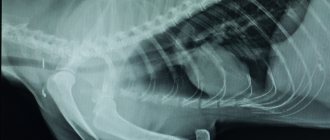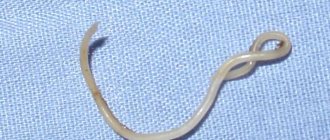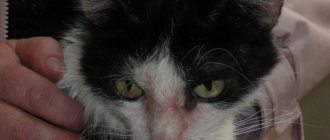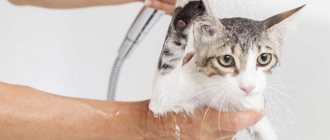What do the wounds look like?
A fairly common problem in young animals is the appearance of wounds in the lips, eyebrows, and less often on the neck. Most often they are localized around the mouth, which makes it possible to suspect an allergic reaction.
Crusts on the ears and under them appear with dermatitis, lichen, or may be a consequence of otitis media. It is quite simple to distinguish a skin disease from inflammation of the ears - with otitis media, the cat feels pain, does not allow him to touch his head, and pus is released from the ear canal. Inflammatory diseases force the animal to comb its ears to scratches, while with skin pathologies, erosions appear regardless of mechanical impact.
In most cases, the wounds are dense crusts or weeping erosions. In this case, wool grows both from the scab and under it, which can be seen if it is separated from the skin. The disease can be accurately diagnosed only after a series of examinations. First of all, you need to do a test for lichen. In veterinary clinics, this is done by shining a special lamp and examining scrapings from the affected area.
Allergic reaction as a cause of rashes
Quite often, sores on a cat’s face appear in response to a change in diet. In this case, it does not matter at all what the pet is fed - natural food or dry food. Allergic reactions can occur in any animal, but the risk group includes:
- Kittens up to three months;
- Animals weakened by disease;
- Cats that have recently changed owners;
- Elderly animals;
Allergies in kittens are associated with poor diet. Often the appearance of wounds around the mouth is observed in the first days after the kitten arrives in its new home. This is explained by the fact that the animal’s body is simply not ready to suddenly switch from mother cat’s milk to “adult” food - food, fish, meat.
Allergic dermatitis around the mouth can also appear in adult animals that have changed owners. This is primarily due to the stress that the cat experiences in the first days in a new home. The situation gets worse if other animals live in the family. In addition, new owners may simply not know what they fed their pet before, and a sudden change in diet due to stress contributes to the development of an allergic reaction.
A sudden change in the usual diet can also negatively affect the health of a cat that has recently had an illness or an elderly animal. A weakened body will quickly react with an allergic reaction and the appearance of scabs on the furry pet’s face.
The peculiarity of food allergies in cats is the absence of itching. If the sores on a cat’s face do not itch and do not cause any discomfort to the animal, and their appearance is definitely associated with a change in diet, you can be 90% sure that this is a hypersensitivity reaction.
Treating an allergic reaction is easy. It is necessary to give the animal any antihistamine, after consulting with a veterinarian about acceptable dosages. This can also be done over the phone, but only if the owner is sure of the nature of the animal’s rash. Next, you need to change the diet, returning to the cat’s usual food, or replacing the food with hypoallergenic food or gentle natural food.
Sores on a cat's face photo
Dermatitis in cats
Dermatitis is a disease of the epidermis, predominantly of an inflammatory nature. Pathology can be triggered by the action of fungi or pathogenic bacteria, which most often appears in weakened animals. The risk group includes older cats, animals with vitamin deficiency and a history of any chronic diseases.
Quite often people who have adopted a street kitten encounter dermatitis on the face. Such a disease in this case is caused by a lack of vitamins due to the lack of normal nutrition in a stray animal. This leads to weakened immunity and the development of dermatitis.
A characteristic feature of this group of diseases is itching in the area of the rash. If a cat has crusty sores on its face, and the animal behaves restlessly and constantly tries to scratch the scabs, the likely cause of this symptom is dermatitis.
Dermatitis can appear in response to flea, tick or mosquito bites, or a fungal infection. The strong immunity of a healthy animal copes with these phenomena on its own, but when the body weakens, scabs appear on the cat’s face, neck and ears. As a rule, in young animals under one year of age, dermatitis is associated with the activity of parasites, and in older cats, older than 6-7 years, with autoimmune reactions of the body.
If all else fails
The most difficult moment for a loving owner is when he tries different methods one after another, but nothing works. The cat has a sore on her neck, a blood scab, which is also beginning to rot. Until you find the cause, you need to fight at least the effect so as not to trigger the disease. In this case, it is best to choose Terramycin or Amidel spray. They help dry wounds very well and relieve inflammation. But the effect will be temporary, since we have not yet eliminated the cause. However, it is important not to make the situation worse with sepsis, so continue to look for treatment options and in the meantime, keep using the spray or ointment.
We recommend reading: The cat is drooling after deworming
Description of possible causes
We need to start with the fact that hairless breeds of cats most often suffer from sores on the chin, due to an innate predisposition to acne. In other breeds, this symptom more often indicates signs of allergies, fungal and bacterial infections. In any case, treatment should begin only after considering all possible options:
- Injury. A fall from a height, an unsuccessful landing, a fight or playing with other animals can cause various types of injuries. A sore on the chin can be the result of torn skin or a deep cut from claws. If you treat the wound with miramistin or chlorhexidine in time, you can avoid the addition of a secondary infection. If the wound is deep, you can cover it with a bandage moistened with levomekol. The main thing is that the pet does not tear off the compress and lick the medicine. If redness, swelling or pus appears, it is necessary to exclude the possibility of bacterial infection.
- Eosinophilic granulomas. In cats, it most often appears as a result of food allergies or flea dermatitis. They can affect the entire face, oral mucosa and limbs. They look like red sores that often appear on the chin and cheeks. Itching is not always pronounced, but if the process of secondary infection is complicated, deep wounds may appear from scratching. As a therapeutic measure, first of all, the option of changing the diet is considered. Ideally, they immediately switch to hypoallergenic food. It is also mandatory to carry out anti-parasitic treatment of the pet according to the instructions, based on weight and age.
- Allergy. For many decorative breeds, the issue of proper nutrition is very acute. It doesn’t always work out the way the owners want it or it’s convenient for them. We are talking about combining natural food with dry food. This is the most common cause of sores on the chin, ears and lips in cats. Here you will have to make a choice in favor of one type of food (natural or dry) and abandon the combination completely. It is also necessary, if possible, to exclude the option of the animal’s access to the master’s table, since even a small piece of stolen meat from breeds such as Bobtail, Maine Coon or Sphynx can provoke a severe aggravation. In rare cases, the reaction can be caused by dishes, so it is recommended to completely avoid plastic bowls. We also cannot exclude the possibility of parasite activity (fleas, ticks, worms), which can also cause sores to appear in different parts of the body.
- Acne. The “eternal” problem of hairless breeds, due to the peculiar location of the follicles. It occurs in other cats, but not as often. It appears in the form of several dozen black or brown pimples. Locations: chin, ears, brow ridges and limbs. Acne is often complicated by a secondary infection, which causes severe itching. Due to severe scratching, large sores often form on the chin. There are times when a pet tears the skin until it bleeds. And if treatment is not started in time, there will only be more wounds and they will not have time to heal. For minimal lesions, it is recommended to wipe the affected areas with a chlorhexidine solution several times a day. If a secondary infection is present, antibiotic therapy may be necessary.
- Bacterial damage. Almost always acts as a secondary infection in allergies, lichen, acne and other pathologies accompanied by severe itching. To determine the type of microbe, deep plucks are taken from the affected areas and sent for cytology. Most often it is staphylococcus. In difficult cases, seeding cannot be avoided. For small lesions, antiseptic treatments and taking control of the underlying disease causing the symptoms are indicated. In severe cases, hormonal therapy is used.
Types of diseases: causes and symptoms
Mechanical damage
Sores in the oral cavity in cats are the result of injuries of varying severity. Often, a pet bites the inside of its cheek while eating, as a result of which a wound forms inside the mouth, which can cause inflammation in the cat. Also, sores near the lips are the result of thermal, chemical and electrical burns. Veterinarians warn owners that if a cat burns its mouth outside or inside, they should immediately contact a veterinary clinic, since there is a high probability of damage to internal organs, which can lead to dangerous complications and death of the animal. When a pet is burned, not only soreness and redness are observed, but also other symptoms:
- indecisiveness when trying to eat, and sometimes the pet refuses to eat altogether;
- pain syndrome;
- increased salivation;
- resistance when owners try to look at the mouth;
- inflammation of the mucous membrane, in which there is a high probability of infection.
Pathology caused by a foreign body
When damaged by a third-party object, the animal’s mouth often festers due to an infection.
Cats often like to play with various special toys, and some of them like to chew twigs. If a foreign object enters the oral cavity, the animal's palate, inner cheek, or mucous membrane in the jaw area may be damaged. If you don’t pay attention to the sore in time, it will soon fester, a black coating may appear, and the seals’ mouth may smell unpleasant. Such symptoms signal an inflammatory process and infection in the oral cavity.
Infections and other pathogenic microorganisms that provoke stomatitis
This oral disease in cats is characterized by an inflammatory process in the gum area and at the top of the throat. Veterinarians have not been able to fully understand the reasons for the development of the disease, but the main factor in the appearance of sores is an inadequate reaction to substances with which the upper part of the teeth comes into contact. It is possible to recognize a disease in the mouth area of a cat by the following symptoms:
- meow;
- restless behavior;
- inability to eat;
- unpleasant odor from the mouth;
- whitish or gray coating on the mucous membrane;
- pain that intensifies when the cat opens and closes its mouth;
- swelling of the salivary glands in cats and red tongue;
- weight loss.
How to recognize a fungal infection?
If a cat has a white coating on its tongue, this indicates a fungal infection.
A cat's white tongue and various sores around the mouth are often the result of fungal activity in the cat's body. The main source of the problem is the proliferation of pathogenic microorganisms such as Candida albicans. The main sign of a fungal infection is a whitish coating and light bumps that appear on the mucous membrane of the mouth or near the lips. The following factors can influence the disease:
- other diseases in the cat’s oral cavity;
- long-term use of antibacterial drugs;
- reduced defense mechanisms of the immune system.
If a cat has a sore mouth for a long time and fungal sores are detected, and treatment is not carried out in a timely manner, then there is a high probability of developing pathologies that are dangerous to the health and life of the pet. Oral fungi are especially dangerous for kittens with weak immune systems.
Gum inflammation
Seizures that appear in a cat’s mouth are a signal of the development of an inflammatory reaction. Low quality food can affect the sore, and when a pet’s gums become inflamed, the following symptoms are additionally recorded:
- redness of the mucous membrane;
- edema;
- bleeding gums;
- pain that worsens when eating.
How to recognize an inflammatory process in the tongue?
Sores near the mouth may indicate an inflamed tongue, such a disease is called glossitis. The development of the disease is influenced by infection, mechanical damage, irritation and other unpleasant factors. When inflamed, the root of the tongue turns red and swells, and other alarming symptoms are observed:
- increased salivation;
- refusal to eat;
- strong pain.
Impaired salivation
When a cat develops spots on the tongue and rots in the mouth, this may indicate improper function of the salivary glands. The following factors can influence sores in a cat’s mouth:
- Excessive saliva production. Pain in the oral cavity and pathological growths can occur due to hyperfunction of the salivary glands. The problem may also be the pet's inability to swallow the liquid that appears. A dangerous cause of increased salivation is rabies.
- Salivary gland cyst or mucocele in a cat. A tumor that forms in the mouth is the result of a damaged integrity or the gland itself. The pet is worried about sores in the mouth, fever, difficulty breathing, and pain.
Sores on a cat's chin photo
Finally, I would like to remind you about lichen, which can also manifest itself in the form of sores on the chin. It is most often diagnosed in outdoor cats. Pets can become infected through objects that may contain fur containing fungal spores (carrier, comb, clothing). Characteristic signs of lichen are a red rim around the spot and weeping inside. Very quickly the lesion remains without hair and peeling appears. You need to be careful with lichen, as all family members can become infected with it. Therefore, the slightest suspicion of this disease should result in a visit to the veterinarian.
Some cat owners, when acne appears on their pet's chin, do not perceive it as a serious danger. Most people hope that acne will disappear on its own after some period of time. But, as practice shows, ignoring this problem often leads to dangerous consequences for the health of the animal. In order not to lead to a worsening of the situation, everyone should know what can contribute to the development, how the pathology manifests itself, and also what measures should be taken to get rid of it.
Additional symptoms that accompany salivation
Constant salivation, which ends with an alarm signal - the cat has a constantly wet chin, may be accompanied by additional signals. The following manifestations should alert owners:
- the pet swallows regularly and noisily;
- after a night or day's sleep, large wet spots remain on the rug;
- the animal begins to wash itself more often, and rubs its paw not the whole body, but only the muzzle;
- The fur on the cat's chest resembles icicles - it collects in wet clumps.
If salivation is caused by rabies, it is not difficult to determine the dangerous disease. The pet completely refuses food and fluids and is afraid of light. The cat prefers to hide in dark corners, refuses to contact its owners, and becomes aggressive and angry.
What are black dots on a cat's face?
If you find black spots on your cat's chin, first of all you should make sure that these are acne. After all, dark rashes can be the result of parasite excrement or dried droplets of blood. To check your assumptions, you need to try to remove the dots; if nothing works, then it means acne.
Acne on a cat's chin
Every person who has a cat at home should understand that the animal’s skin is covered with sebaceous glands. When exposed to unfavorable factors, the pores become clogged and plugs form. This process is quite lengthy and can take place over several years.
The plugs, which are subcutaneous fat, become black as a result of oxidation. If treatment is not started in time, the problem can develop into an inflammatory process.
Black spots on a cat's chin can appear either immediately or gradually. Most often, rashes occur on the lower lip, chin and around the neck. In advanced cases, the disease progresses and causes acne to spread to the thighs and abdomen.
Note! Every animal can face the problem of blackhead formation. In this case, the pathology develops very slowly. The pet begins to experience discomfort only in the later stages.
Types of acne in cats
In what cases is it necessary to go to the veterinarian?
The active secretion of saliva in cats performs several functions in the body. Salivation is a physiological process on which the functioning of the digestive organs depends. Saliva can also soften food and make it more pliable, which helps prevent damage to the lining of the mouth, teeth and gums. In addition, saliva has a positive effect on the receptors of the tongue.
Now it becomes clear why cats need saliva. However, its excess amount does not always indicate normal and healthy functioning of the body - it often means that the animal is sick. You need to start sounding the alarm for your pet in the following cases:
- The cat began to rub its face against the furniture or door frame.
- The pet has a wet chin, as well as a wet neck and chest.
- The animal feels unwell, which manifests itself in lethargy and weakness.
You may be interested in: Why does the cat's eye become cloudy: causes, treatment methods
In this case, you need to visit a veterinarian soon, who will examine the cat and identify the cause of excessive salivation.
Main causes of rashes
If black specks appear on a cat's chin, then this condition can be caused by numerous factors. Most often, problems arise as a result of the individual characteristics of the animal’s body. To reduce the amount of blackness, you need to carefully care for your pet.
The reasons that provoke this condition also include:
- poor nutrition;
- pathologies of the sebaceous glands;
- hormonal disorders;
- liver diseases;
- decreased immunity.
To determine the cause of the problem, it is recommended to immediately contact a veterinarian at the first sign.
Poor hygiene
The most common problem. As a result of poor quality care, blackheads and dark-colored pimples appear on the cat’s body. This occurs due to the large accumulation of sebaceous glands. Excessive care for your pet can also lead to the development of pathology.
Hormonal disbalance
Both humans and cats can experience hormonal imbalances. As a result of this, several diseases arise. The most common is the appearance of blackheads. The cause of the pathology may be improper behavior of the owner, overfeeding, inappropriate food, as well as improper behavior of the owner and taking hormonal medications.
Infection
Problems with the skin are observed even in cats that do not go outside and are properly cared for by their owners. Cats often develop black acne as a result of infections. As a result, your pet develops painful ulcers.
Causes of the disease
External and internal factors are involved in the development of disease symptoms in cats.
External factors often include:
- Wool dirt;
- Constant friction;
- The influence of parasites;
- Using soap when bathing an animal;
- High or low temperatures;
- Microbial infection.
Internal factors that can cause weeping eczema in cats include:
- Weak immunity;
- Endocrine pathology;
- Ovarian dysfunction;
- Diseases of internal organs.
Causes of rashes depending on location
According to experts, one of the most common causes of blackheads in cats is pollution. But at the same time, this condition can be a consequence of other reasons.
Black spots on the lower jaw
Dark-colored sores can appear on the lower jaw in cats due to hereditary predisposition. In this case, you can ensure the normal condition of the skin with the help of properly selected hygiene products.
Black dots on a cat's lower jaw
On the lips
Having noticed black spots on a cat's lips, every owner should be wary. This manifestation may indicate the development of fungal diseases. At the first signs, it is important to immediately seek qualified help, since it is impossible to independently determine the type of infection.
Diagnostic procedures
Having identified pathological changes in the pet’s oral cavity, you should consult a veterinarian for advice.
A seemingly healthy cat may have various sores in the mouth, so owners need to examine it more often to identify the problem early. If the oral mucosa is covered with black, white and other pathological spots, then you should consult a veterinarian. To make a diagnosis, sometimes a specialist only needs a visual examination of the damaged area. If it was not possible to determine the severity and cause of the sore in this way, then additional laboratory and instrumental examinations are carried out.
Return to contents
Treatment for black spots on the chin in cats
If black specks appear on your cat's chin, it is important to immediately seek qualified help. At a veterinary clinic, a specialist will determine what the disease is like and select the most effective treatment.
Most often, it is recommended to treat a cat with products intended for local treatment. For this purpose, special shampoos, tar soap or antiseptic solutions are used. For advanced diseases, medications and injections are prescribed and adjustments to the usual diet are recommended.
Improved pet care
A pet with this disease does not require special care. It will be enough to follow the recommendations given by the veterinarian. You can speed up the healing process by daily washing your cat's bowls from which the animal drinks and eats.
During the treatment process, it is very important to systematically remove dirt and food debris from your pet’s chin and gums. It is best to do this after every meal.
Treatment with antiseptics
If black crusts or dots appear on a cat’s face, experts recommend treating them with antiseptics. You can cure acne in a kitten or adult cat using tar soap. The affected area should be treated with it several times a day.
As for antiseptics, it is recommended to use hydrogen peroxide or chlorhexidine for pets. These drugs are used to treat the mouth and affected areas. 15 minutes after this, it is recommended to apply a cotton piece of fabric soaked in a hot decoction of calendula to the sore spot. Then the lesion should be wiped with salicylic acid, and then an ointment for acne in animals should be applied.
Antiseptic treatment of black spots on the chin of cats
Bathing with special shampoos
To help the animal get rid of black spots on the body, special antiseborrheic shampoos are used. They recommend washing the cat several times a day if pathology is observed throughout the body. If the disease manifests itself in certain areas, then it is enough to bathe the pet once a day.
When to go to the vet
It is almost impossible to determine on your own why a cat has black spots on its chin. If the disease begins to develop and the skin at the site of the lesion begins to go bald, then this is a sign that signals that you need to contact a veterinarian immediately.
Rash prevention
To prevent black spots from appearing on the animal’s body, it needs to be provided with good living conditions and fed only from a glass, iron or ceramic bowl. In addition, it is imperative to clean the animal, give it vitamin complexes and ensure a balanced diet.
Cleaning your pet
It is necessary to carefully monitor the cleanliness of your pet's fur, especially on the chin. To prevent contamination, you should bathe your pet with special shampoos.
Balanced diet
A balanced diet will help speed up the healing process and prevent the development of the disease. In this case, it is best to give preference to specialized products that are suitable for a specific breed. Experts recommend feeding your pet not only dry food, but also including boiled fish, chicken, eggs, carrots and grass in the diet.
Note! It is strictly forbidden to feed your pet cheap food, as it contains a large amount of preservatives and flavorings.
Balanced nutrition for cats
Vitamin complexes
A loving owner must provide his pet with a sufficient amount of vitamins. They must be contained in food, so preference should be given to special balanced feed of good quality. In addition, the animal should be systematically given vitamin complexes that will ensure the health and well-being of the pet.
Black spots on a cat's chin may indicate a pathology that occurs when the sebaceous glands become inflamed. When abnormalities appear, the animal feels well at first, but symptoms of the disease appear after a long time. The domestic cat becomes like a yard cat and is unkempt. Why this happens and how to cope with the pathology can only be suggested by a specialist who will professionally determine the cause and prescribe qualified treatment.











